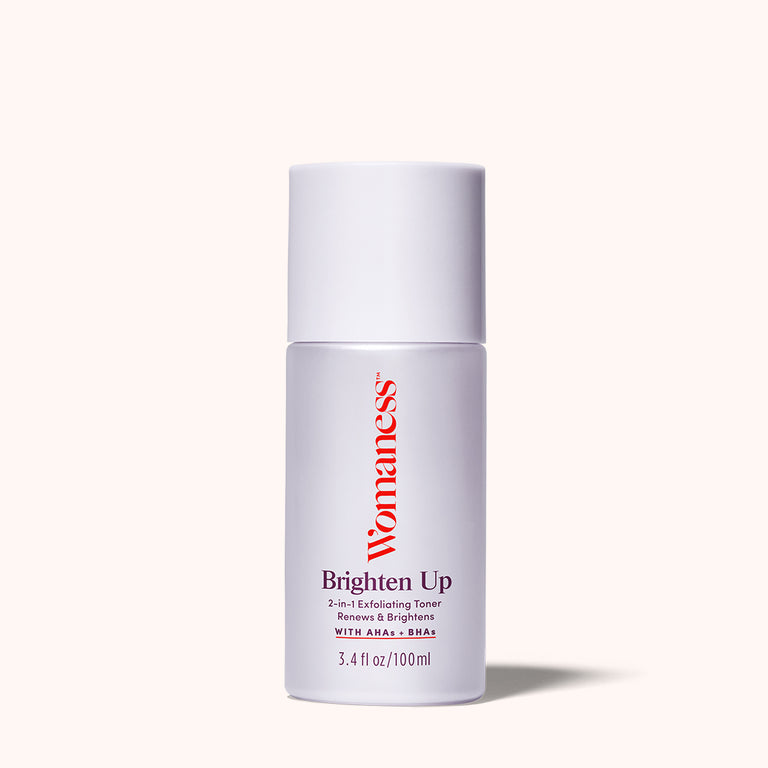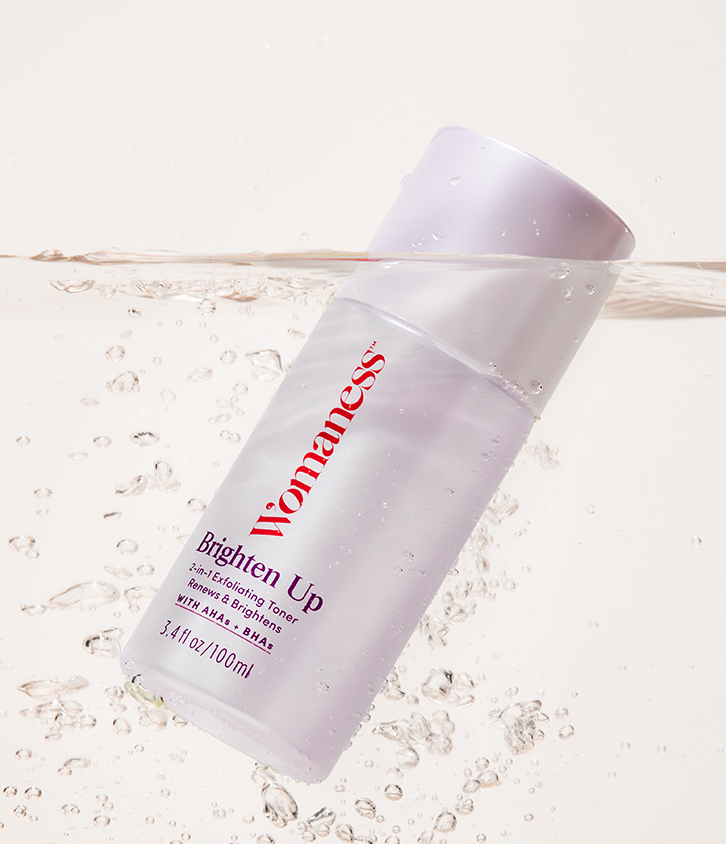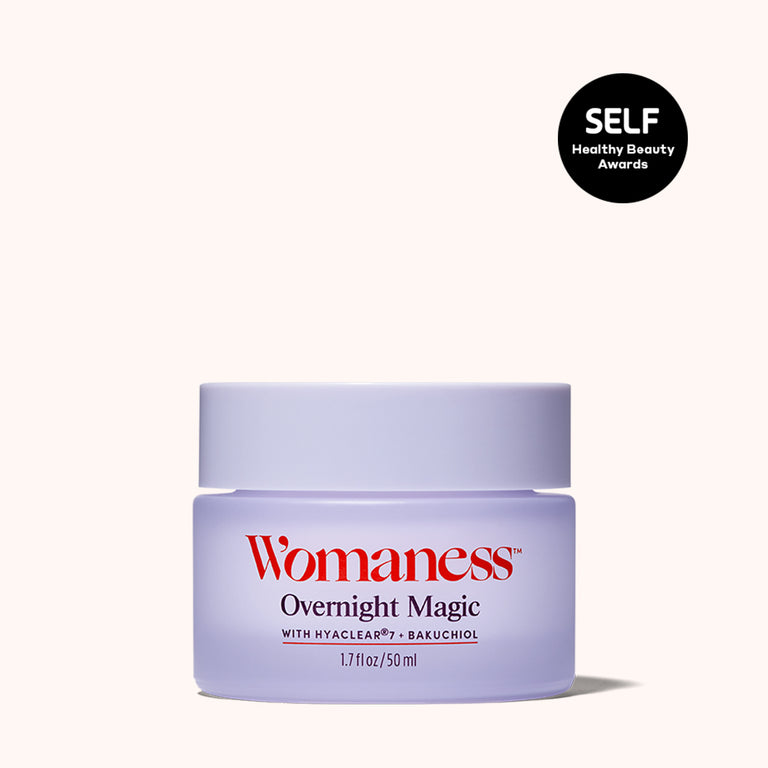By Womaness Editors 3-Minute Read
 Your face is constantly creating new skin cells, but that doesn’t mean the old (dead) ones automatically see themselves out. Instead, they’ll cling to your healthiest skin beneath, dulling your complexion, clogging pores, and drawing more attention to lines and wrinkles than you might prefer.
Your face is constantly creating new skin cells, but that doesn’t mean the old (dead) ones automatically see themselves out. Instead, they’ll cling to your healthiest skin beneath, dulling your complexion, clogging pores, and drawing more attention to lines and wrinkles than you might prefer.
Talk about overstaying a welcome.
Thankfully, you can nudge these unwelcome guests out the door for good: regular exfoliation is all it takes to put your best face forward. And exfoliation is even more important for skin in menopause as it becomes drier, skin turnover slows down, fine lines and wrinkles increase, and dark spots may increase. Thankfully, exfoliation eases all of the above.
Read on to learn all the ins and outs of exfoliation for your most gorgeous menopausal skin yet.
Exfoliation Methods: Physical vs. Chemical
As an informed exfoliant shopper, you must know about the two primary exfoliation methods.
The type that scrubs your dead skin cells away is called physical—or mechanical—exfoliation. It creates friction with abrasive scrubs (think apricot pits or sugar crystals), brushes, sponges, or loofahs to slough away dead skin debris. But physical exfoliation isn’t recommended for menopausal skin because it can damage the skin barrier, worsen skin concerns, and cause unnecessary drying.
Using chemicals—usually in liquid or mask form—to cause dead skin to shed without any friction is called chemical exfoliation. Hydroxy acids and enzymes are chemical exfoliants for helping skin turnover.
Chemical exfoliants are excellent for skin in menopause because they’re so gentle—they’re the best kind to look for when you hit the stores looking for an exfoliant!
"Physical exfoliation isn’t recommended for skin in menopause because it can damage the skin barrier, worsen skin concerns, and cause unnecessary drying."
Types of Chemical Exfoliants
Now that you know that chemical exfoliants are best for changing skin in menopause, it’s time to understand what ingredients to look for.
Alpha Hydroxy Acids (AHAs)
Amazing for mature skin, AHA, also known as lactic acid, gently exfoliates while improving the appearance of fine lines, brightening your skin tone, and enhancing texture. It also helps keep skin hydrated due to its ability to bind water within the skin—a huge win for menopausal skin that tends to dry out easily.
Beta Hydroxy Acids (BHAs)
This heavy-hitting acid is one that virtually makes pores disappear. Also called salicylic acid, BHA mimics the natural exfoliation process of younger skin by unclogging and clearing pores, exfoliating the buildup of dull, dead skin on the skin’s surface. It also helps clear and control excess oil production without dryness or irritation, which reduces the appearance of pores. You’ll love it.
Enzymes (PHAs)
Enzymes are a gentler way to exfoliate superficial layers of skin. They brighten dull skin and may help with fine lines and mild discoloration due to their exfoliation effect. PHAs—aka Bromelain—are an enzyme found in the pineapple plant...and our favorite chemical exfoliant.
"Chemical exfoliants are excellent for skin in menopause because they’re so gentle."
What is the Best Exfoliant for Menopausal Skin?
Chemical exfoliants are the BEST for menopausal skin! And a combination of the types of exfoliants covered above will give you the most beneficial results.
That’s why we created Brighten Up—a gentle chemical exfoliant SPECIFICALLY created for menopausal skin concerns.
It blends AHAs, BHAs, PHAs and more into a leave-on, 2-in-1 exfoliating toning liquid so you can enjoy all the above benefits, including exfoliation, reducing the appearance of fine lines and pores, evening skin tone, smoothing skin’s texture, and MORE.
How & When to Exfoliate
A liquid exfoliant like Brighten Up is simple to work into your existing routine. After cleansing and patting skin dry, moisten a cotton pad with a few drops and swipe over a clean face, neck, and décolleté. No need to rinse! You’re good to go.
You can use exfoliants up to 2x a day, morning and night, but there’s no need to overdo it. If you’re new to exfoliants, it’s especially important to take things slow. Begin by using 2 to 3 times per week, gradually increasing to your desired amount of use.
Want to find out how much your skin can tolerate? Pay attention to your skin. If you’re experiencing flaking, redness, or swelling, take a break to evaluate if your exfoliant might be the root of the issue.
Don’t combine chemical exfoliants like Brighten Up with retinol or vitamin C simultaneously. Alternate using them on different days and, as always, use at least SPF 35 during the day.
More For You
7 Beauty Tips for Dry Menopausal Skin
What's Happening Here? Changes in Hair, Skin, & Nails
Ingredient Spotlight: Retinol vs. Bakuchiol




